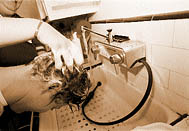![]() s
millions of Americans have discovered, modern chemistry has made it possible
to color hair for a day—or change it forever (or at least until
it grows out) with a permanent tint. For the timid, there are temporary
dyes, which form a colored film over each hair and wash off with shampoo.
s
millions of Americans have discovered, modern chemistry has made it possible
to color hair for a day—or change it forever (or at least until
it grows out) with a permanent tint. For the timid, there are temporary
dyes, which form a colored film over each hair and wash off with shampoo.
|
|
In this RealVideo clip, Jeneill, Artistic Director of the Oxenrose hair salon in San Francisco, describes the term "chemical haircut" and why you don't want one! |
The bolder try semipermanent dyes. These dyes contain alkali to swell and soften the cuticle cells. The pigment molecules in semi-permanent dyes are all small enough to sneak between the swollen cuticle cells and get inside the hairs.
Just as different natural pigments combine to make natural hair colors, a mixture of synthetic pigments blends to make a variety of hair dye colors. A burgundy hair dye, for instance, contains both red and blue pigments. The smallest molecules, the red pigments, worm their way much deeper into the hairs than the larger molecules, the blue pigments. Over the next few weeks, some pigment molecules wash away with each shampooing. The larger molecules, which haven't penetrated as deeply, wash away first. That's why the color of semipermanently dyed hair fades and changes tone with each washing.
Finally, for the truly adventurous, there are chemicals that cause permanent changes to your hair: bleach and permanent dyes or tints. The solution that is used to bleach hair contains alkali to soften the cuticle and hydrogen peroxide to release oxygen. This oxygen penetrates your hair and reacts with the natural pigments in the cortex, oxidizing them and breaking them down. The bleach mixture also contains modifiers to slow the release of oxygen so that the reaction happens over a period of about an hour.
 After
bleaching your hair to remove some of the natural pigments, you can put
another color in. Permanent hair dyes start out as colorless molecules
that are small enough to squeeze between the cuticle cells and get inside
the hairs. These tiny molecules react with hydrogen peroxide to become
colored molecules. They also form clusters that are too large to wash
out of the hair, leaving your hair permanently colored. That's why you
can't judge a hair color by looking at the mixture before you put it on
your hair. The color of the pigments will change as the colorless molecules
react with hydrogen peroxide.
After
bleaching your hair to remove some of the natural pigments, you can put
another color in. Permanent hair dyes start out as colorless molecules
that are small enough to squeeze between the cuticle cells and get inside
the hairs. These tiny molecules react with hydrogen peroxide to become
colored molecules. They also form clusters that are too large to wash
out of the hair, leaving your hair permanently colored. That's why you
can't judge a hair color by looking at the mixture before you put it on
your hair. The color of the pigments will change as the colorless molecules
react with hydrogen peroxide.
At the end of a successful coloring operation, the giant pigment molecules are securely in place behind the translucent cuticle, which is once again protecting the cortex. Voilà! You look wonderful.
Or maybe not. Suppose you don't like the color and you want to change your mind. One way to get these giant molecules out of the hair is to damage the cuticle so that they fall out. Not a good idea, but people sometimes do this by mistake when they try to perm or straighten colored hair.
Another way to get the giant molecules out of the hair is with a color stripper or reducer, which reverses the action of the hydrogen peroxide, breaking the giant molecule back down into tiny molecules that can be rinsed away. Color stripper removes the added color, but it doesn't return your hair to its natural shade. While the oxygen from the hydrogen peroxide was making giant molecules, it was also destroying some of your natural pigments. At this point, even the most adventurous should be cautious.
Color stripping leaves the cuticle a little damaged so that the hair is very porous, likely to soak up any color that comes along. Trying another permanent color is risky. Some of those tiny tint molecules may still be caught inside the hair. Give them a little peroxide, and they'll react and darken the hair again. After color stripping, it's safest to use temporary colors while you give your hair a chance to grow out.
![]()
Sounds risky, doesn't it? But
what's life without a little risk? In a week and a half, I'll take my
unkempt mop of hair to my trustworthy hairdresser and do a little experimenting.
I know that blondes have fun, but I've started wondering about redheads,
and how much fun they have. I'm still in the research phase on this. I'll
get back to you in a few years with definitive results. But I have decided
that there's nothing like a little color to improve a Bad Hair situation.

